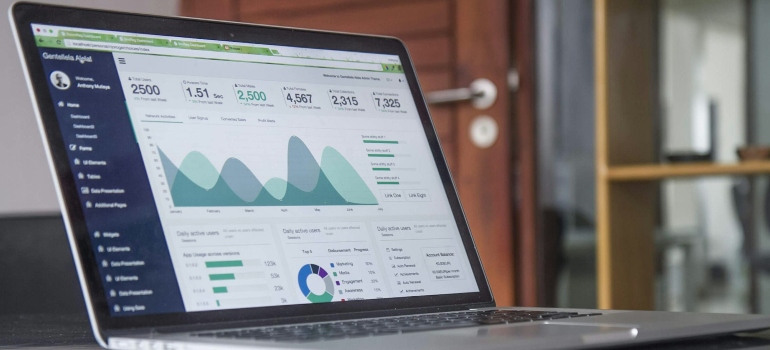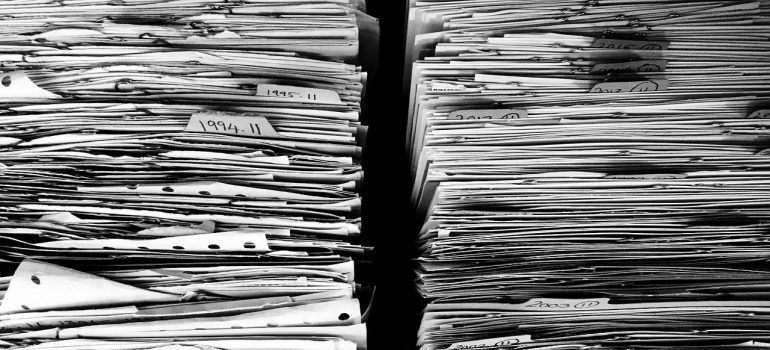Reducing Waste with a Paperless Move
When you move, whether it’s your home or business, you generate a lot of waste. A significant part of this waste comes from paper—think about all the boxes, labels, receipts, and documents involved. Switching to a paperless relocation can significantly reduce your carbon footprint. This Hansen Bros. Moving & Storage guide on reducing waste with a paperless move will help you understand how to make your relocation more eco-friendly by going digital and cutting out unnecessary paper use!
Why Go Paperless for Your Move?
Moving, whether it’s for your home or business, often involves a lot of paper use, from packing materials and labels to documents and receipts. Going paperless for your move can significantly benefit the environment and improve efficiency. Here’s why making the switch to a paperless move is advantageous for both the planet and your pocket.
Environmental Impact
Opting for a paperless move can have a profound positive impact on the environment. Reducing paper consumption helps conserve natural resources and minimize pollution, contributing to a healthier planet.
- Reduces the demand for paper, saving trees and reducing deforestation. Cutting down on the need for paper products means fewer trees need to be cut down, which helps preserve forests and the wildlife that lives there.
- Lowers energy consumption and pollution from paper manufacturing. The process of making paper is energy-intensive and produces significant pollution. Going paperless reduces the demand for paper production, thereby decreasing the associated environmental footprint.
- Decreases waste sent to landfills. Less paper use means less waste to dispose of, reducing the amount of trash that ends up in landfills and helping to alleviate the strain on waste management systems.
These environmental benefits highlight the importance of considering a paperless move with your chosen Washington movers. Helping protect natural resources and contributing to a more sustainable and eco-friendly lifestyle are just a few of the advantages.

Economic and Efficiency Benefits
In addition to environmental advantages, going paperless can also offer significant economic and efficiency benefits. Streamlining processes and reducing costs associated with paper can lead to a more organized and secure move:
- Saves money on paper, printing, and storage. Eliminating the need for paper and printing supplies reduces costs, saving money that can be better spent on other aspects of the move.
- Simplifies organization and retrieval of documents. Digital documents are easier to organize and access, reducing the time and effort needed to manage paperwork during the move.
- Enhances data security and backup. Digital records are easier to back up and protect, ensuring important documents are safe from physical damage or loss.
These economic and efficiency benefits make a strong case for reducing waste with a paperless move. Saving money and time, as well as providing greater security and convenience, can make your move smoother and more efficient. Hence, adopting a paperless move allows you to enjoy these environmental and economic benefits, contributing to a more sustainable future while simplifying your relocation process.
Preparing for a Paperless Move
Transitioning to a paperless move requires thoughtful preparation. Assessing your current paper usage, setting clear goals, and selecting the right tools can make your move more efficient and environmentally friendly.
Assessing Current Paper Usage
The first step in preparing for a paperless move is to understand how much paper you currently use. Conduct an audit of paper usage in your home or office. Look at all the areas where paper is utilized, such as packing materials, labels, documents, and receipts. This audit will help identify high-usage areas and pinpoint opportunities to switch to digital solutions.
For example, you might discover that a significant amount of paper is used for printing invoices or receipts, which can easily be converted to digital formats. Identifying these areas is crucial for developing a strategy to reduce paper waste.
Setting Clear Goals
After assessing your paper usage, the next step is to set clear goals for your paperless move with Seattle moving services. Define your objectives for reducing waste with a paperless move. Consider what you want to achieve, whether it’s reducing paper waste, saving money, or improving efficiency. Setting achievable short-term and long-term goals is important.
Short-term goals might include switching to digital communication and reducing the use of printed materials during the move. Long-term goals could involve fully integrating paperless practices into your daily operations. Clear goals will provide direction and help measure progress throughout the transition.
Choosing the Right Tools
Selecting the appropriate tools is essential for a successful paperless move. Document management systems (DMS) can help organize and store digital files efficiently. These systems enable easy retrieval and management of documents, reducing the need for physical paper. Cloud storage solutions offer secure and accessible storage options, allowing you to store and access documents from anywhere.
E-signature software simplifies the process of signing documents electronically, eliminating the need for printed contracts and agreements. Communication and collaboration tools, such as digital note-taking apps and project management software, can further reduce the need for printed materials by facilitating seamless digital communication.

Implementing a Paperless Relocation Strategy
Transitioning to a paperless move involves reducing paper use through a comprehensive strategy that digitizes documents, changes daily operations, and supports everyone involved besides your office movers in Seattle. Taking these steps ensures a smooth and effective shift to a paperless system.
Digitizing Existing Paper Documents
The first step in implementing a paperless strategy is to digitize your existing paper documents. Scan important documents and store them digitally to reduce physical clutter and make information more accessible. Organize your digital files in a structured system, creating folders and subfolders that mimic your current filing system.
Consistent naming conventions and clear categorization will help you locate documents quickly and efficiently. Ensuring data backup and security is crucial; use reliable cloud storage solutions and regularly update backups to prevent data loss.
Changing Daily Operations
To fully embrace a paperless move, it’s essential to change daily operations. Use email and messaging apps instead of paper communications to streamline information exchange. Replace paper forms with digital versions, which can be filled out and submitted electronically.
Mobile devices can be used for note-taking and information sharing, reducing the need for printed materials. Adopting these practices not only minimizes paper use but also improves communication efficiency and document management.
Training and Supporting Everyone
Successful implementation of a paperless strategy requires training and support for all involved. Provide training on new digital tools to ensure everyone is comfortable and proficient with the technology. Encourage feedback and suggestions from family members or employees to identify potential issues and areas for improvement. Promoting a culture of continuous improvement helps maintain the momentum of the paperless initiative and encourages ongoing adoption of eco-friendly practices.
Overcoming Challenges in Going Paperless
Transitioning to a paperless move can present various challenges, including resistance to change, technical issues, and legal compliance concerns. Addressing these challenges effectively before booking your local movers in Seattle is crucial for a successful transition.
Resistance to Change
Resistance to change is a common hurdle when implementing a paperless strategy. Addressing concerns by explaining the benefits of going paperless is essential. Highlight how it can save time, reduce costs, and contribute to environmental sustainability.
Sharing success stories can also provide motivation, showing real-life examples of the positive impact of going paperless. Offering incentives and recognition for adopting paperless practices can further encourage acceptance. For instance, rewarding employees who consistently use digital tools can create a
Technical Issues
Technical issues can disrupt the process of going paperless. Ensuring a reliable internet connection and IT support is fundamental to overcoming these challenges. A stable internet connection is necessary for accessing cloud storage and digital communication tools. Regularly updating software and tools helps prevent compatibility issues and enhances security.
Providing technical assistance when needed is also important. That can involve having an IT support team ready to troubleshoot problems or offering training sessions to help users become familiar with new technologies. Proactive measures like these can minimize disruptions and keep the transition on track.

Legal and Compliance Matters
Navigating legal and compliance matters is another critical aspect of going paperless. Understanding legal requirements for document storage and disposal ensures that your digital transition adheres to regulations. Different industries have specific rules regarding how long documents must be retained and how they should be disposed of.
Ensuring your digital storage methods are secure and compliant is also essential before hiring long-distance movers in Seattle. This involves using encryption, secure access controls, and regular audits to protect sensitive information. Therefore, adhering to these practices not only safeguards your data but also builds trust with clients and stakeholders, demonstrating your commitment to responsible data management.
Measuring the Impact of a Paperless Move
Measuring the impact of a paperless move is crucial to ensure its success and sustainability. Tracking progress and achievements, along with fostering continuous improvement, helps maintain momentum and demonstrates the benefits of going paperless.
Tracking Progress and Achievements
Regularly reviewing your paperless goals and achievements is essential for understanding the effectiveness of your efforts. Set specific, measurable goals at the outset, such as reducing paper usage by a certain percentage or fully transitioning to digital document management within a set timeframe. Regular check-ins, whether monthly or quarterly, can help you assess progress and identify areas where further improvements are needed.
Adjusting your approach based on what works best is another key element of tracking progress. If certain strategies are not yielding the desired results, be prepared to pivot and try alternative methods. For instance, if one type of digital tool isn’t being adopted as expected, consider offering additional training or exploring more user-friendly options.
Celebrating milestones and successes keeps motivation high and reinforces the benefits of reducing waste with a paperless move. Acknowledge achievements such as reaching significant reductions in paper use, completing the digitization of key documents, or successfully implementing new digital tools. Recognizing these accomplishments can help maintain enthusiasm and commitment among team members.
Continuous Improvement
Staying updated with new technologies and tools is vital for continuous improvement. The digital landscape is constantly evolving, offering new solutions that can enhance efficiency and sustainability. Regularly researching and integrating the latest advancements can keep your paperless strategy current and effective.
Encouraging innovation and eco-friendly practices within your organization fosters a culture of continuous improvement. Promote open dialogue about ways to reduce paper use further and enhance digital workflows. Encourage team members to share their ideas and experiences, which can lead to innovative solutions and better practices.
Embracing eco-friendly practices beyond just going paperless can also contribute to continuous improvement. For instance, reducing energy consumption by optimizing digital tools or implementing sustainable office practices can complement your paperless efforts.

Broader Implications of a Paperless Move
A paperless move offers substantial benefits beyond immediate practical advantages, impacting both residential and commercial environments.
Operational Efficiency
For both homes and businesses, going paperless streamlines workflows and boosts productivity. Digital processes reduce the time spent on manual tasks, making it easier to manage daily activities. This efficiency leads to faster service delivery in business settings, enhancing customer satisfaction. Accessible digital records also enable better decision-making, as information is readily available for analysis and planning.
Environmental and Social Impact
Reducing paper usage contributes to a healthier planet by conserving natural resources and lowering pollution. Both households and businesses benefit from supporting sustainability and eco-friendly practices. This shift not only reduces environmental footprints but also sets a positive example, encouraging others to adopt paperless methods.
Future Trends and Developments
Advances in digital technology and automation will continue to make paperless practices more accessible and efficient. The growing emphasis on sustainability in both homes and businesses drives the adoption of these practices, promising a future where eco-friendly methods are the norm. As more organizations and individuals recognize the benefits of reducing waste with a paperless move, the potential for global impact and collective action increases.
Why Choose Us
History
Hansen Bros. Moving & Storage is locally owned and operated by the same family for four generations, since 1890. We have a well-established reputation for service quality and reliability with a high percentage of repeat household and commercial clients.
Professionalism
We’re a certified ProMover by the American Moving and Storage Association with A+ rating with the Better Business Bureau, voted “Best in Western Washington” in 2009 and from 2011 to 2016 by KING5. Our company is fully licensed and insured and member of WMC and AMSA.
Value
Hansen Bros. Moving & Storage provide free, no-obligation in-home estimate and competitive rates, including low minimum rates for shipments moving under 300 miles. We’ve set a refund policy for unused packing materials and three Puget Sound locations to help clients save on travel fee costs.



